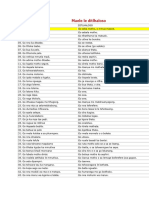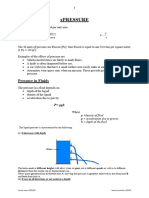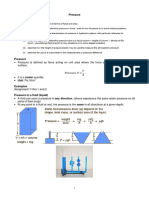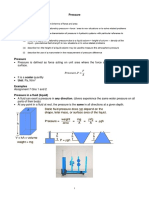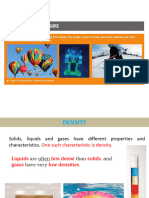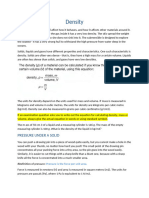0 ratings0% found this document useful (0 votes)
8 viewsGP6 - Pressure 1
GP6 - Pressure 1
Uploaded by
wengiemotshegwe1. Pressure is defined as force per unit area and is measured in Pascals (Pa). Atmospheric pressure at sea level is approximately 100,000 Pa.
2. Pressure depends on depth and density of a fluid. The greater the depth or density, the higher the pressure. Pressure can be calculated as P=ρgh, where ρ is fluid density, g is gravity, and h is depth.
3. Barometers are used to measure atmospheric pressure. A mercury barometer uses a column of mercury to measure air pressure. Higher air pressure supports a taller mercury column.
Copyright:
© All Rights Reserved
Available Formats
Download as DOC, PDF, TXT or read online from Scribd
GP6 - Pressure 1
GP6 - Pressure 1
Uploaded by
wengiemotshegwe0 ratings0% found this document useful (0 votes)
8 views3 pages1. Pressure is defined as force per unit area and is measured in Pascals (Pa). Atmospheric pressure at sea level is approximately 100,000 Pa.
2. Pressure depends on depth and density of a fluid. The greater the depth or density, the higher the pressure. Pressure can be calculated as P=ρgh, where ρ is fluid density, g is gravity, and h is depth.
3. Barometers are used to measure atmospheric pressure. A mercury barometer uses a column of mercury to measure air pressure. Higher air pressure supports a taller mercury column.
Original Title
GP6_ Pressure 1
Copyright
© © All Rights Reserved
Available Formats
DOC, PDF, TXT or read online from Scribd
Share this document
Did you find this document useful?
Is this content inappropriate?
1. Pressure is defined as force per unit area and is measured in Pascals (Pa). Atmospheric pressure at sea level is approximately 100,000 Pa.
2. Pressure depends on depth and density of a fluid. The greater the depth or density, the higher the pressure. Pressure can be calculated as P=ρgh, where ρ is fluid density, g is gravity, and h is depth.
3. Barometers are used to measure atmospheric pressure. A mercury barometer uses a column of mercury to measure air pressure. Higher air pressure supports a taller mercury column.
Copyright:
© All Rights Reserved
Available Formats
Download as DOC, PDF, TXT or read online from Scribd
Download as doc, pdf, or txt
0 ratings0% found this document useful (0 votes)
8 views3 pagesGP6 - Pressure 1
GP6 - Pressure 1
Uploaded by
wengiemotshegwe1. Pressure is defined as force per unit area and is measured in Pascals (Pa). Atmospheric pressure at sea level is approximately 100,000 Pa.
2. Pressure depends on depth and density of a fluid. The greater the depth or density, the higher the pressure. Pressure can be calculated as P=ρgh, where ρ is fluid density, g is gravity, and h is depth.
3. Barometers are used to measure atmospheric pressure. A mercury barometer uses a column of mercury to measure air pressure. Higher air pressure supports a taller mercury column.
Copyright:
© All Rights Reserved
Available Formats
Download as DOC, PDF, TXT or read online from Scribd
Download as doc, pdf, or txt
You are on page 1of 3
1
B An elephant weighing 200kN
PRESSURE standing on an area of 0.2 m2.
C A girl of weight 0.5 kN wearing
Pressure is the force applied per unit area. stiletto-heeled shoes standing on an
area of 0.0002m2.
5. What is the pressure 100 m below the
surface of sea water of density 1150 kg/m3?
6 At a weather station the pressure is found
to be 100 000 Pa while the average density
of air is found to be 1.25 kg/m3. Calculate
the average depth of the air above the
The SI units of pressure are Pascals [Pa]. One weather station.
Pascal is equal to one Newton per square meter (1
Pa = 1N/m2).
Atmospheric Pressure
This is the pressure due to the weight of the
atmosphere on earth. The atmospheric pressure at
Examples of the effects of pressure are:
sea level is about 1.0 x 105 Pa (100 000 Nm-2). We
Stiletto-heeled shoes are likely to mark
do not feel this pressure because it is balanced by
floors,
our blood pressure.
A knife is often sharpened before use,
A car with tyres that have a small surface Effects Of Atmospheric Pressure
area easily sinks in sand or mud. Bleeding: If the atmospheric pressure is
Astronauts wear space suits when on smaller than the blood pressure nose
mission. These provide pressure to balance bleeding may occur. This is common
body pressure. during very hot days as well as at a high
altitude.
Pressure in Fluids Collapsing Can: If air is removed from a
can using a vacuum pump, the wall of the
The pressure in a fluid depends on can collapses as air inside the can is
depth of the liquid gradually removed. The same effect can be
density of the liquid seen when using a drinking straw on mini-
acceleration due to gravity juice packaged drink.
Magdeburg Hemispheres: If two
P= ρgh hemispheres are fitted together and air
Where removed, it becomes very difficult to
ρ =density of fluid separate the hemispheres.
g = acceleration due to gravity Drinking Straw: Atmospheric pressure
h = depth of the fluid. helps you to push the drink up as you suck
using a straw.
Classwork Rubber Sucker: When a rubber sucker is
pressed against a smooth surface, air is
1. Calculate the pressure if a 150N force is removed. The atmospheric pressure pushes
exerted on a surface area of 0.5m2. and holds the cup against the surface.
2. A concrete block of mass 90 kg and a Suction cups are used to lift metal sheets,
square base of side 2 m is resting on the glass panes or holders for towels and coats.
ground. What is the pressure it exerts on Siphoning water: when siphoning water
the ground? from a large tank to a smaller one,
3. A pressure of 10 Pa acts on an area of atmospheric pressure helps you by pushing
3.0m2. What is the force acting on the area?
the water up the pipe.
4. Which of the following will damage a
wood-block floor that can withstand a pressure
of 2000 kPa ?
A A block weighing 2000kN standing
on area of 2 m2.
Physics notes: PRESSURE leemok productions 2021©
2
Measuring Atmospheric Pressure
Atmospheric pressure can be measured using a
barometer. Types of barometers include
Simple Mercury Barometer
Aneroid Barometer
Fortin’s Barometer
Simple Mercury Barometer
This instrument is used to measure atmospheric In figure (b), a gas supply is connected to the
pressure. It consists of a cylindrical tube filled manometer. If the gas pressure is greater than
with mercury which is then inverted into a atmospheric pressure it increases the pressure at A
mercury bath. A small amount of the mercury which causes level A to go down while level B
flows into the bath but most remains in the tube. rises. At equilibrium the pressure at A must equal
Atmospheric pressure acting on the surface of the to the pressure at C since they are both at the same
mercury in the mercury bath supports the mercury level.
column in the tube. The
pressure at Y due to mercury column XY is equal Thus the gas pressure at A, PA is equal to the
to the atmospheric pressure. pressure at C, PC. (PA = PC.)
But PC is equal to the pressure at B, PB
(atmospheric pressure) + the pressure due to
mercury column BC (gh).
Therefore the gas pressure PA is given by,
PA = PB + gh
Where h = barometric height-height of the column
BC
= density of liquid in u-tube
g = acceleration due gravity
PB = atmospheric pressure
The height h is directly proportional to the
atmospheric pressure and as such is used as a unit Classwork
of measuring pressure. The height h is about 760 7. In a simple mercury barometer, the tube
mm (0.76 m) mm at sea level. Thus 760 mm of supports 73cm of mercury. What is the
mercury is equal to 1 atmosphere (1 atm). atmospheric pressure in Pascal’s? Density
of mercury is 13 600 kg/m3
U tube manometer 8. What would be the height of a water
A u-tube manometer is used to measure gas barometer if atmospheric pressure is 1 x
pressure. It consists of a u-tube filled with 105pa and the density of water is 1.0 x 103
mercury. In figure (a), the level of the liquid in kg/m3
both arms of the u-tube is the same since only 9. In a manometer used to measure gas
atmospheric pressure is acting on the liquid in the pressure, the gas supports a 100 mm of
u-tube. (the gas has not been connected yet.) The mercury column, calculate the gas
pressures at A and at B are the same and are equal pressure. Atmospheric pressure is 760mm
to atmospheric pressure. Hg.
10. The pressure at the base of a mountain is
105 000 Pa while the pressure at the
mountain top is 15 000 Pa. If the average
density of air is 1.25 kg/m3, calculate the
height of the mountain.
Physics notes: PRESSURE leemok productions 2021©
3
Weather Maps
Atmospheric pressure and other atmospheric
conditions such as temperature, humidity and
cloud pattern can be used to predict weather. Such
conditions can be plotted on a map to form a
weather map.
An isobar is a line on a weather map that joins
places with the same atmospheric pressure.
Pressure on a weather map is quoted in pressure
units called millibars.
1 Bar = 100 000 Pa 1 atm (1 Bar =
1000 Millibars)
Cyclone
A cyclone is a region where the atmospheric
pressure decreases as you approach the centre of
the region. i.e it has low pressure at the centre.
Wind blows spirally from a high to a low pressure
region. Cyclones are characterised by wet, windy
weather. The closer the isobars the stronger the
wind and chances of rain. Examples of cyclones
include whirlwinds, typhoons, hurricanes,
tornadoes, willi-willies etc.
Anticyclone
An anticyclone is a region with high pressure at
the centre.
It is characterised by dry dense air.
Physics notes: PRESSURE leemok productions 2021©
You might also like
- Maele Le DitlhalosoDocument2 pagesMaele Le Ditlhalosowengiemotshegwe100% (10)
- MaeleDocument2 pagesMaelewengiemotshegwe75% (4)
- CIE IGCSE Physics (0625) Pressure NotesDocument22 pagesCIE IGCSE Physics (0625) Pressure Notes9322483% (53)
- CHP 11-13 PDFDocument106 pagesCHP 11-13 PDFLittle-psyco :30% (1)
- GP6 PressureDocument5 pagesGP6 Pressuredinakempho3No ratings yet
- GP6 PressureDocument5 pagesGP6 Pressureellenjune632No ratings yet
- GP6 PressureDocument6 pagesGP6 Pressurerasnatar7259No ratings yet
- PressureDocument26 pagesPressureMuhammad Amin SuhaimiNo ratings yet
- PressureDocument26 pagesPressureMuhammad Amin SuhaimiNo ratings yet
- Atmopheric PressureDocument34 pagesAtmopheric PressureTaufik PamisNo ratings yet
- 08 PressureDocument39 pages08 PressureElyn SofiaNo ratings yet
- Year9 PressureDocument56 pagesYear9 Pressurejasonasomah123100% (1)
- Atmospheric PressureDocument12 pagesAtmospheric Pressureanwar9602020No ratings yet
- 06 PressureDocument3 pages06 PressureaudreyalexandralesmanaNo ratings yet
- Physics 11 - PressureDocument51 pagesPhysics 11 - PressureTiffany Yeoh100% (1)
- Pressure NotesDocument4 pagesPressure Notesmuhammadrayyansaif2009No ratings yet
- Phy433 Lab Report 4Document23 pagesPhy433 Lab Report 4Michael McBertNo ratings yet
- C7 Pressure NotesDocument12 pagesC7 Pressure Notestasheenuzzaman313No ratings yet
- C7 Pressure NotesDocument8 pagesC7 Pressure NotesMuhammad ZulqarnainNo ratings yet
- Unit 7,8,9Document23 pagesUnit 7,8,9Adalbert MugambiraNo ratings yet
- C7 Pressure NotesDocument20 pagesC7 Pressure Notestasheenuzzaman313No ratings yet
- ProblemsDocument3 pagesProblemsimPERFECTme09No ratings yet
- Thrust PressureDocument11 pagesThrust Pressureadultboy4680No ratings yet
- Pressure and DensityDocument15 pagesPressure and DensityMuhammad Ali AbbasNo ratings yet
- 3a. Fluid StaticsDocument33 pages3a. Fluid StaticsAhra AlegriaNo ratings yet
- Physics 1.11 - PressureDocument29 pagesPhysics 1.11 - PressureAJAYI PETER100% (1)
- GRFP01 Gr11 Ch03 AllDocument22 pagesGRFP01 Gr11 Ch03 AllAidanNo ratings yet
- Chapter 2 - Measurement of PressureDocument32 pagesChapter 2 - Measurement of PressureHazlinda FazreenNo ratings yet
- Hydraulics Chapte2Document3 pagesHydraulics Chapte222100975No ratings yet
- PressureDocument30 pagesPressurerodel.verzosaNo ratings yet
- CH - 18 - Den - PressureDocument46 pagesCH - 18 - Den - PressureThaw ThawNo ratings yet
- PressureDocument4 pagesPressuremorekigift99No ratings yet
- Pressure: Edited by Ms Shivani Kaur SihraDocument83 pagesPressure: Edited by Ms Shivani Kaur Sihrakrishnasri neelapu100% (1)
- Chapter5. PressureDocument35 pagesChapter5. PressureQIONG LIUNo ratings yet
- Kcsephysicspaper1 2021 NotesDocument68 pagesKcsephysicspaper1 2021 Notesowadeselline7No ratings yet
- Pascal's LawDocument3 pagesPascal's LawDean BehiNo ratings yet
- DensityDocument8 pagesDensitytangenai2401No ratings yet
- FLUIDSDocument55 pagesFLUIDSMonville RedNo ratings yet
- Liquid Pressure and Pascals LawDocument16 pagesLiquid Pressure and Pascals Lawitsamazing496100% (1)
- Problems On PressureDocument4 pagesProblems On Pressurevinod kumarNo ratings yet
- Chapter 10 Lecture Notes: P GH P GH +P F (A /A B W Q V/ T Av A V A V P V Gy + (1/2) V Gy F Av/lDocument13 pagesChapter 10 Lecture Notes: P GH P GH +P F (A /A B W Q V/ T Av A V A V P V Gy + (1/2) V Gy F Av/lvijayabharathi_vijivijiNo ratings yet
- Pressure - Hydrostatics - Grade 10Document27 pagesPressure - Hydrostatics - Grade 10Ashleigh JarrettNo ratings yet
- Exp SC 7 - Chapter 08Document14 pagesExp SC 7 - Chapter 08megamind publicationNo ratings yet
- REVIEW PressureDocument54 pagesREVIEW Pressurenuraisahaah69No ratings yet
- 2023 Lect1 FLUID STATIC Application of Hydro StaticDocument65 pages2023 Lect1 FLUID STATIC Application of Hydro StaticReyhan FachriAnsyahNo ratings yet
- Ch. 5Document13 pagesCh. 5Sandy ShohdyNo ratings yet
- Fluid MechanicsDocument45 pagesFluid MechanicsSean Eric CoronadoNo ratings yet
- CHAPTER-2 PressureDocument41 pagesCHAPTER-2 PressureJohn David RomasantaNo ratings yet
- PRESSUREDocument31 pagesPRESSURESANGEETA WADHWANo ratings yet
- Fluida (English)Document56 pagesFluida (English)aliNo ratings yet
- O Level Physics Pressure NotesDocument28 pagesO Level Physics Pressure NotesMarvel ComicsNo ratings yet
- Barometer and Atmospheric PressureDocument2 pagesBarometer and Atmospheric PressureEhtisham RiazNo ratings yet
- ABS - Ch03 Aerodinamica BasicaDocument19 pagesABS - Ch03 Aerodinamica BasicaHugo MardueñoNo ratings yet
- Pressure in Stationary FluidsDocument8 pagesPressure in Stationary FluidsHIPAPNo ratings yet
- Pressure BuoyancyDocument6 pagesPressure BuoyancyJamelle ManatadNo ratings yet
- Aircraft Aerodynamics: Iiae 2016Document31 pagesAircraft Aerodynamics: Iiae 2016Pushkar KolharNo ratings yet
- 4 Pressure BuoyancyDocument8 pages4 Pressure Buoyancythinkiit100% (1)
- Chapter 1a GasesDocument12 pagesChapter 1a GasesKarunakarNo ratings yet
- Sec 11.7Document6 pagesSec 11.7Adalia PioNo ratings yet
- Pressure, Heat and Temperature - Physics for Kids - 5th Grade | Children's Physics BooksFrom EverandPressure, Heat and Temperature - Physics for Kids - 5th Grade | Children's Physics BooksNo ratings yet
- Pressure, Resistance, and Stability of Earth American Society of Civil Engineers: Transactions, Paper No. 1174, Volume LXX, December 1910From EverandPressure, Resistance, and Stability of Earth American Society of Civil Engineers: Transactions, Paper No. 1174, Volume LXX, December 1910No ratings yet
- Globalisation 2Document11 pagesGlobalisation 2wengiemotshegweNo ratings yet
- (H2 Bio) Chapter 1 Cell BiologyDocument29 pages(H2 Bio) Chapter 1 Cell BiologywengiemotshegweNo ratings yet
- Parts of The EyeDocument9 pagesParts of The EyewengiemotshegweNo ratings yet
- TP5 - Heat Capacity & Latent Heat 1Document5 pagesTP5 - Heat Capacity & Latent Heat 1wengiemotshegweNo ratings yet
- GP5 - Energy, Work & Power 1Document8 pagesGP5 - Energy, Work & Power 1wengiemotshegweNo ratings yet
- TP1 - Kinetic Theory of Matter 1Document2 pagesTP1 - Kinetic Theory of Matter 1wengiemotshegweNo ratings yet
- Diane Ka Ga Botsalano - Iafrika - SetswanaDocument1 pageDiane Ka Ga Botsalano - Iafrika - SetswanawengiemotshegweNo ratings yet
- Pupils XiDocument3 pagesPupils XimukisredmiNo ratings yet
- Comments prEN 1991-1-3 2020 Part V - Arched RoofsDocument37 pagesComments prEN 1991-1-3 2020 Part V - Arched RoofsusonNo ratings yet
- Lecture I (Climatology)Document14 pagesLecture I (Climatology)emanueldaniel205No ratings yet
- CanadaDocument2 pagesCanadaJohn AriasNo ratings yet
- Top 10 Hypotheses Regarding The Bermuda TriangleDocument2 pagesTop 10 Hypotheses Regarding The Bermuda TriangleDami Thamiet0% (1)
- Cristian R. Delos Angeles C.P. For Typhoon-Cagliliog EsDocument30 pagesCristian R. Delos Angeles C.P. For Typhoon-Cagliliog EsRAMEL VALENCIANo ratings yet
- CBSE Class 7th Science Value Based Questions Chapter 7 Weather, Climate and Adaptation PDF DownloadDocument12 pagesCBSE Class 7th Science Value Based Questions Chapter 7 Weather, Climate and Adaptation PDF Downloadpravin161079No ratings yet
- Sci W2Q3 J.C. BARREDO 9CAMPOSDocument6 pagesSci W2Q3 J.C. BARREDO 9CAMPOSJo BarredoNo ratings yet
- Wcas WCAS D 20 0168.1Document13 pagesWcas WCAS D 20 0168.1Rowena BrionesNo ratings yet
- Geography Revision Booklet Final2 PDFDocument98 pagesGeography Revision Booklet Final2 PDFNoliNo ratings yet
- Bams BAMS D 21 0121.1Document19 pagesBams BAMS D 21 0121.1equipo facu eduNo ratings yet
- Mkwi 4201Document7 pagesMkwi 4201Renny PurwantieNo ratings yet
- Warming Trends Increasingly Dominate Global Ocean: ArticlesDocument7 pagesWarming Trends Increasingly Dominate Global Ocean: ArticlesP. SinskyNo ratings yet
- Ce 6001 Hydrology Question BankDocument4 pagesCe 6001 Hydrology Question BankShanmuga SundaramNo ratings yet
- Weather-at-its-Worst JessDocument36 pagesWeather-at-its-Worst JessYuri YuriNo ratings yet
- Chapter 2 On AH 2015 For HE StudentsDocument19 pagesChapter 2 On AH 2015 For HE Studentswako wadayNo ratings yet
- Cyclone:: Cyclone, Types, Effects and Formation of CycloneDocument3 pagesCyclone:: Cyclone, Types, Effects and Formation of CycloneprachiNo ratings yet
- In Flight Guide CJ3 Plus Edition 5Document35 pagesIn Flight Guide CJ3 Plus Edition 5AmandoNo ratings yet
- VFR Navigatio Va N LogDocument2 pagesVFR Navigatio Va N LogCarlos PáramoNo ratings yet
- EOTA Year 9 INS 2 2023 - 2024Document4 pagesEOTA Year 9 INS 2 2023 - 2024yokemooi yinNo ratings yet
- Look at Those Dark Clouds in The Sky. I Think It - /rain/!Document4 pagesLook at Those Dark Clouds in The Sky. I Think It - /rain/!Bex TasicNo ratings yet
- PHYS0629/PHYS1056: Assignment 2 (Solution)Document5 pagesPHYS0629/PHYS1056: Assignment 2 (Solution)iamnottomNo ratings yet
- BHS InggrisDocument6 pagesBHS InggrisIis NurkamilahNo ratings yet
- Estimation of Missing Rainfall Data: Mainly at Meteorological StationsDocument7 pagesEstimation of Missing Rainfall Data: Mainly at Meteorological StationsPruthaviraj BNo ratings yet
- P. B. Shelley, 'A History of A Six Weeks' Tour'Document41 pagesP. B. Shelley, 'A History of A Six Weeks' Tour'FVVNo ratings yet
- Conditionals проверочная работа 4 вариантаDocument1 pageConditionals проверочная работа 4 вариантаarajeskermesNo ratings yet
- ABEn 145 - Tribunalo - Lab 6Document10 pagesABEn 145 - Tribunalo - Lab 6HeliNo ratings yet
- Weather: What Is The Weather Like Today?Document16 pagesWeather: What Is The Weather Like Today?GabrielNo ratings yet
- CB - AS - X - English - A Letter To God - General QsDocument3 pagesCB - AS - X - English - A Letter To God - General QsSachi PatelNo ratings yet
- 1 Lesson-Plan Science8Document5 pages1 Lesson-Plan Science8Jessa Mae Lig-angNo ratings yet
